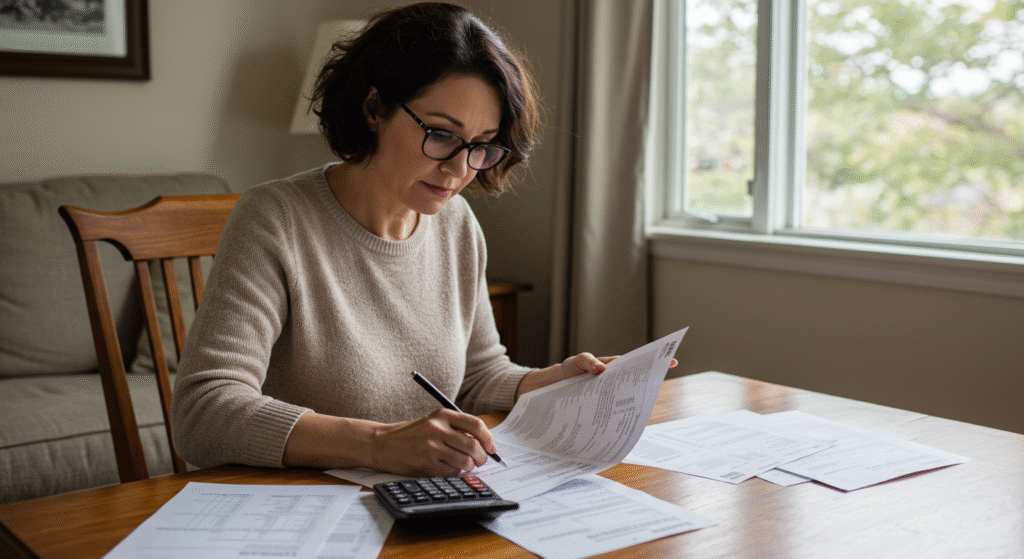Bills pile up and your bank balance never seems to match what you expected. If you’ve ever felt stuck in a loop of late-night money worries, you’re not alone. A real budget isn’t about limiting every dollar, it’s about finding calm in the chaos and taking back control over your money.
Building a budget that actually works brings clarity, reduces stress, and makes room for your goals whether that’s paying off debt, saving for a trip, or just sleeping better at night. More people than ever are discovering how consistent budgeting can lead to a sense of security and real peace of mind. I’ll break down how to create a budget that sticks, step by step, using simple, proven habits so you can finally feel steady, no matter what comes your way.
What It Means to Create a Budget That Sticks

Setting up a budget is one thing making it last is another. When people talk about a budget that sticks, they’re describing a financial plan that actually works in real life, not something you abandon after a few weeks. This kind of budget should fit your needs, flex with everyday surprises, and help you calmly handle bills and spending. Creating a budget that sticks means building routines and tools that keep you on track, no matter what’s happening in your world. Here’s what this looks like in practice:
Budgeting That Fits Daily Life
A budget that lasts isn’t about squeezing pennies until life feels joyless. Instead, it lays out a plan that fits your lifestyle and priorities:
- Realistic categories: You track what you truly spend, like groceries or gas, so the numbers reflect your real life, not wishful thinking.
- Clear priorities: Your most important bills and needs get covered first, reducing stress around essentials like housing or healthcare.
- Room for fun: A solid budget doesn’t ignore simple joys, like eating out or hobbies, it just keeps them planned and guilt-free.
You don’t have to be perfect what matters is that checking your spending doesn’t feel like a chore.
Flexibility as a Core Feature
The best budgets are built to handle surprises. Creating a budget that sticks means you’re ready for car repairs, birthday gifts, or the odd splurge now and then. Here’s what makes a budget flexible:
- Monthly reviews: You look at your budget and adjust as life changes. A new job, higher rent, or less overtime—your budget can handle it when you check in regularly.
- Adjustable spending: If your food costs go up, you can trim another area, like streaming services, without upending your whole plan.
- Buffer funds: Setting aside a little money for “just in case” keeps stress low when life throws a curveball.
A stiff budget cracks under pressure. One that bends sticks around.
Tracking: More Clarity, Less Guesswork
Budgets that last are built on honest tracking. This means knowing what you earn and where every dollar goes:
- Use a notebook, a simple spreadsheet, or a budgeting app, whichever fits your style.
- Record all your income: paychecks, side gigs, and every bit that comes in.
- Track spending in main categories: housing, utilities, food, debt, savings, and fun.
When you actually see your numbers, you stop guessing and start making choices with confidence.
Why Zero-Based and 50/30/20 Work
Some tried-and-tested methods can help a budget stick:
- Zero-based budgeting: Every dollar you earn gets an assignment either paid out, saved, or put toward debt—leaving nothing “extra” unplanned.
- 50/30/20 guideline: You split money into 50% needs, 30% wants, and 20% to savings or debt payoff. This framework creates balance and limits overspending.
Choose what suits you best, but having a structure makes monitoring easier.
Quick Tips for a Budget You’ll Actually Follow
Building a budget that works involves habits, not just numbers. Here are habits that help make it stick:
- Automate bills and savings transfers
- Sleep on major purchases
- Keep credit card limits lower than your max
- Celebrate small wins, like making a week without unplanned spending
- Rethink “wants” by asking, “Would I still spend if I earned this cash today?”
When you make budgeting automatic and rewarding, sticking to it starts to feel natural.
Common Mistakes and How to Avoid Them
It’s easy to fall off track, but knowing the usual missteps helps you stay ahead. Some common mistakes:
- Guessing your expenses instead of tracking every dollar
- Setting unrealistic goals you can’t maintain
- Forgetting future or irregular expenses (like yearly insurance or holidays)
- Ignoring to review and tweak each month
- Cutting out all fun, making the budget too strict
The fix? Be honest with yourself. Build in wiggle room. Reward progress. Adjust as you go.
Key Takeaways in a Nutshell
| Make It Fit | Keep It Flexible | Track and Adjust |
|---|---|---|
| Use real numbers, not guesses | Review monthly | Log spending regularly |
| Cover needs first | Shift money as needed | Celebrate small wins |
| Leave space for wants | Prepare for surprises | Check your progress often |
A budget that sticks isn’t just a set of numbers it’s a living plan that makes your money work for you, day after day.
Step-by-Step Guide to Building a Realistic, Lasting Budget

Putting a budget together that actually sticks can feel like putting together a jigsaw puzzle without the picture on the box. Every piece matters, and missing just one detail can throw off the whole system. It’s not about perfection. It’s about consistency, honesty and making choices that fit your real life. Below, I break down the steps I use to build a budget that feels possible from the start and actually lasts longer than a couple of paychecks.
Figure Out Your Income Absolutely Everything
You can’t build a budget if you don’t know your starting point. Start by totaling all your sources of income—not just your salary. This means including every dollar that flows your way, whether regular or random.
- Salaried income: Look at your net (after-tax) amount, not gross. Check recent pay stubs or direct deposit records.
- Variable income: If you freelance, work hourly, or get tips, average your last 3–6 months. Use the lowest month as your base so you’re always prepared.
- Side gigs: Add earnings from part-time jobs, consulting, or even online sales.
- Irregular payments: These include bonuses, commissions, child support, or rental income if you have tenants.
Add it all up. Honesty here is key: rounding up helps dreams, but rounding down helps reality. Write out sources and amounts so you get a crystal-clear monthly number. This number anchors every other budget decision.
Track Spending and List Every Expense
Time to put a magnifying glass on where the money actually goes. The goal is to get a complete and honest snapshot—no expense too small, no category ignored.
How to track spending:
- Write it down by hand in a notebook or on a calendar.
- Use apps like Mint, YNAB (You Need A Budget), or your bank’s built-in tracking tools.
- Download your bank and credit card statements for the last few months and comb through every charge.
Separate fixed from variable expenses:
- Fixed expenses: Rent or mortgage, loan payments, subscriptions, insurance these don’t change much month to month.
- Variable expenses: Groceries, gas, dining out, shopping, entertainment, gifts these swing up and down.
Don’t forget annual or semi-annual bills, like car insurance or school fees. Break these down to a monthly amount so nothing sneaks up on you.
Key Tip: When you miss tracking even small cash or quick digital payments, gaps grow. The stricter you are with expense tracking, the easier the next steps become.
Choose a Budgeting Method That Fits
There’s no universal method, but finding the approach that matches your habits makes sticking to the budget easier. Some like it simple, some need structure, while others work best with a cash-in-hand feel.
The most popular frameworks:
- 50/30/20 Rule: Splits net income into needs (50%), wants (30%), and savings or debt (20%). This method is straightforward and good for those who want a balanced plan without overthinking.
- Zero-Based Budgeting: Gives every single dollar a job, from bills to savings, until your income minus expenses equals zero. Ideal for detail-oriented folks or anyone serious about curbing impulse spending.
- Envelope Method: Physically or digitally separates money into category “envelopes.” When a category runs out, no more spending there. This tactile system suits people who overspend easily or want to use mostly cash.
Here’s a quick guide to help you see which fits your lifestyle:
| TYPE | BENEFITS | WHO IT’S BEST FOR |
|---|---|---|
| 50/30/20 Rule | Simple, flexible, good monthly overview | Beginners, busy people, balanced priorities |
| Zero-Based Budgeting | Highly controlled, nothing left unplanned | Detail lovers, strict savers, goal chasers |
| Envelope Method | Tangible limits, stops overspending early | Habitual overspenders, fans of cash budgeting |
Don’t be afraid to mix and match. You might use envelopes for groceries and the 50/30/20 rule for the rest.
Set Realistic Goals and Build in Flexibility
A budget that sticks isn’t rigid. It’s about aiming for progress, not perfection. Unless your budget flexes with real life, you’re more likely to ditch it altogether.
Build goals and some breathing room into the plan:
- Set clear savings or debt-payoff targets: Instead of saying, “Save more,” write down “Add $100 a month to my emergency fund” or “Pay $200 extra on my credit card.”
- Add a buffer: Life throws curveballs. Budget a small “miscellaneous” amount so unexpected costs don’t send you back to square one.
- Use adjustable categories: If your utility bill drops one month, reroute that extra to savings or debt.
- Prep for lumpy expenses: Stash a little each month for yearly costs like car registration or holidays.
With flexible goals and categories, your budget becomes a safety net, not a straitjacket.
Automate, Review, and Adjust Regularly
Let’s face it: willpower alone rarely works for money management. Automation and regular check-ins take the guesswork and temptation out of budgeting.
Here’s how I keep things on track:
- Automate savings: Set up transfers right after payday into a separate account, so saving happens before spending.
- Automate bills: Schedule payments for loans, utilities, and cards to avoid late fees and reduce stress.
- Review each month: Block 20 minutes to look over your budget has your income changed? Are you overspending in one area?
- Adjust as needed: Life shifts all the time. Move money between categories, increase your savings if possible, or rethink goals if priorities change.
Quick monthly review routine:
- Open your tracker or bank app.
- Compare budgeted amounts vs. actual spending.
- Look at next month’s calendar for upcoming extra expenses.
- Shift money where needed.
- Pat yourself on the back for staying engaged.
Automation takes care of routine decisions, while regular reviews give you freedom and flexibility. That’s what turns a one-time effort into a lasting, stress-free routine.
Practical Tips and Traps: How to Make Your Budget Work Long Term

Making your budget last isn’t about being perfect every month. It’s about building habits that work in real life, spotting trouble before it gets out of hand, and knowing how to bounce back when things go sideways. Even the best plan will fall apart if it doesn’t fit your daily routine or if you ignore the traps that throw so many people off. The key is to keep your budget both firm and flexible, so it keeps working year after year.
Quick Tips to Stay on Track
When it comes to making your budget stick, the little things matter most. Here are some tools and tricks I rely on to keep my spending in check, my motivation up, and my goals from drifting out of sight:
- Automate everything you can: Set up auto-pay for bills and savings transfers to remove the temptation to skip or forget.
- Set calendar reminders: Schedule a monthly check-in, even if it’s just 15 minutes, to tweak and review your numbers.
- Make it visible: Keep your budget in a place you see often (your phone, kitchen whiteboard, or planner) so you stay mindful.
- Use budgeting apps: Tools like YNAB, EveryDollar, and Mint make it easy to track spending in real time and spot problems fast.
- Sleep on big purchases: Impulse buys are budget wreckers. Waiting 24 hours before buying gives you time to rethink.
- Buddy up for accountability: Share your budget goals with someone you trust or join an online community for support.
- Practice realistic rewards: Treat yourself for staying on track, but plan those treats. This could be a fancy coffee or a movie night within the fun money category.
- Sort expenses by priority: Cover essentials first (housing, food, transportation). Wants come after needs.
- Bank your small wins: Transfer leftover money in a category to savings as a reward at the end of each month.
- Prepare for trap months: Holidays or back-to-school season can derail even strong plans. Set aside a little extra ahead of time using a “sinking fund” to handle these predictable bumps.
I always say, a budget is a living thing. The more you interact with it, the less scary it gets, and the more control you have.
The Most Common Budgeting Mistakes And How to Dodge Them
Even the most well-meaning budgeter hits a wall now and then. Knowing the usual mistakes helps you sidestep them before they become major setbacks.
Forgetting Hidden or Irregular Expenses
One-time costs like annual subscription renewals or car repairs can blow up your plan if you don’t set aside something each month. I’ve learned that breaking yearly costs into monthly chunks and parking those in a “sinking fund” keeps surprises from feeling like emergencies.
Guessing or Rounding Off Expenses
It’s easy to underestimate what you spend by guessing or rounding down. This always leads to holes in your budget. The fix: Track real numbers for at least one month, right down to the last coffee and parking meter payment. Honest data brings honest results.
Not Tracking Your Spending Consistently
Many people write the budget once then tuck it away. Out of sight, out of mind. I make it a habit to record spending every couple of days just a quick review on my phone so nothing sneaks by me.
Being Too Rigid
Budgets that don’t bend always break. If you treat your budget like a set of rules, not guidelines, frustration sets in fast. Give yourself room to adjust move extra from entertainment to groceries if you need to, or vice versa. Flexibility is the muscle that keeps everything together.
Setting Unrealistic Goals
Trying to slash your grocery bill in half overnight or save hundreds more than you can manage leads to burnout. I set small, steady goals. Knocking out $25 or $50 at a time might sound slow, but those wins build real momentum.
Neglecting the Emergency Fund
Without a cushion, every minor crisis feels major. I always pad my budget with a line for emergencies—even if it’s just $10 a month so I’m covered when life throws the unexpected my way.
Tracking Only the Big Stuff Ignoring Little Purchases
Small daily expenses are like a slow leak in your tire. Coffee shop runs and quick snacks add up fast. I group these into a “miscellaneous” category and check often to make sure they don’t swallow my spare cash.
Living on Credit or Ignoring Debt Repayment
Using credit cards for little gaps in your budget leads to debt spirals. I use cash or debit for daily spending, and any extra goes toward paying down old debt. Even a small, regular debt payment beats letting charges pile up.
Skipping Regular Reviews
If I skip my monthly review, I miss important shifts maybe an app subscription went up or my utility bill dropped. Monthly check-ins help me adjust and stay honest.
Here’s a quick checklist to keep handy:
- Track expenses honestly, every month
- Break big, irregular costs into monthly savings
- Stick to real numbers, not guesses
- Build in flexibility to shift money as needed
- Celebrate small wins and course correct as needed
These habits help your budget survive the long haul, keep your goals in sight, and let you handle life’s surprises with confidence.
Conclusion
A budget that sticks lays the foundation for real freedom. When every dollar has a purpose, stress fades, and I know exactly where I stand. My money choices become deliberate and I can put more toward what matters, whether that’s building savings, paying off debt, or funding goals that spark motivation.
By running my budget with regular check-ins and allowing space for life’s twists, I keep control even when things shift. The more I practice these steps, the more I notice calm and clarity replacing anxiety. Tracking my spending now gives me room to celebrate small wins and handle surprises confidently.
If this guide on how to create a budget that sticks inspired you, share your own tips in the comments below. Let others know how your approach is working or what hurdles you’re facing. Follow along for more practical ways to grow your financial confidence and turn budgeting into a tool for lasting peace of mind. Thank you for reading and being part of this journey toward better money habits.





